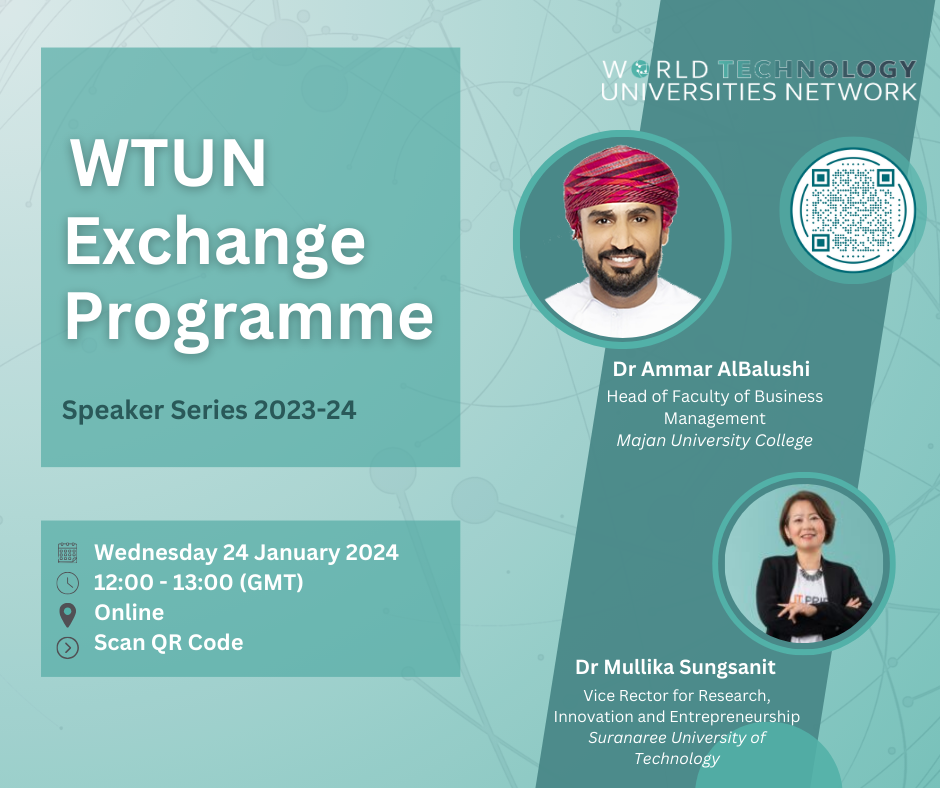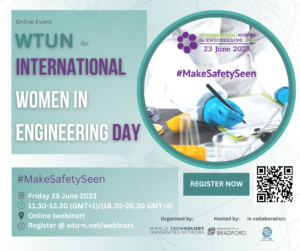Dr. Ammar Al-Balushi is Head of Faculty of Business Management at MUC. Dr. Ammar holds a PhD degree in Management, with a particular focus on Tourism Development and Strategy, studied at Glasgow Caledonian University, London Branch. He has completed his Bachelor’s degree at Glasgow Caledonian University and Master’s in International Management at Strathclyde University. Dr. Ammar has previously worked as a lecturer and a module leader in Management, Marketing and Strategy at Glasgow Caledonian University and the University of Essex from 2013 to 2018. His current research focuses on tourism development, marketing, branding, economic, social and environmental impacts of tourism and management of tourism sites. Dr. Ammar brings an industrial and international perspective to his teaching informed by scholarly research focusing on the GCC and MENA regions. He has also written a book chapter on the management of impacts of tourism.
Webinars
Past Webinars
WTUN for International Women in Engineering Day 2024- ‘Enhanced by Engineering’
On Wednesday 26th June, we marked International Women in Engineering Day (INWED) via an online event.
To watch the replay of the live event – Click here to watch the replay of this event
Date: Wednesday 26 June
Time: 14.00 (UK Time/GMT+1)
Platform: Online webinar via Teams
This event was to mark this year’s ‘WTUN for International Women in Engineering Day (INWED)’. Once again, the breadth of topics covered demonstrates the plurality and varied areas of expertise in which Network members are engaged; this time coming together under the 2024 theme ‘Enhanced by Engineering’. Read more about INWED and the Women’s Engineering Society here.
WTUN for INWED: Speakers
Dr Karin Nachbagauer, Professor of Applied Mathematics, University of Applied Sciences Upper Austria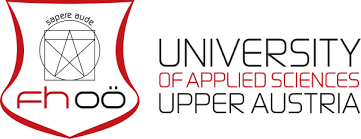
Topic: ‘Intercultural Female Collaboration (International Summer Academy in Engineering for Women)’
https://pure.fh-ooe.at/de/persons/karin-nachbagauer
Dr Rohayanti Hassan, Associate Professor and Quality and Strategy Manager, Faculty of Computing, Universiti Teknologi Malaysia.
Topic: ‘Waterfall versus Agile Software Project Management: The Challenges of Women Software Engineers’
https://utmscholar.utm.my/Scholar/ScholarInfoDetails/MMMX
Dr Rardchawadee Silapunt, Associate Professor, Department of Electronic and Telecommunication Engineering, King Mongkut’s University of Technology Thonburi
Thonburi
Topic: ‘Moo-ving Forward: Revolutionizing dairy Estrus Detection with KomilO’
https://kirim.kmutt.ac.th/converis/portal/detail/Person/54159741?auxfun=&lang=en_GB
Dr Sirirat T. Rattanachan
Associate Professor, School of Ceramic Engineering, Suranaree University of Technology
Topic: ‘Revolutionizing Bone Surgery with Customized Calcium Phosphate Bone Augmentation’
https://www.researchgate.net/profile/Sirirat-Rattanachan-2
Recent Webinars
WTUN for World Engineering Day
The full schedule can be found here: WTUN for World Engineering Day Schedule
Join us as we mark World Engineering Day for Sustainable Development via a series of online events in the week commencing Monday 4 March 2024.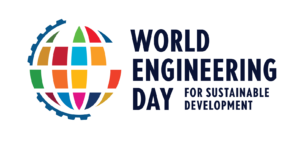
WED is an opportunity to celebrate engineering and the contribution of the world’s engineers for a better, sustainable world. This year’s theme is “Engineering Solutions for a Sustainable World”
Follow the links below for details of specific events:
Monday 4 March: University of Applied Sciences, Upper Austria hosts ‘Latest Developments in Energy Storage and Conversion’.
Tuesday 5 March: Hindustan Institute of Technology & Science hosts WTUN Sharing Session ‘Advancing Diversity and Inclusion in STEM’
Thursday 7 March: University of Bradford hosts ‘Theory into practice– addressing Water-Energy-Health-Environment (WEHE) Nexus’
In case you missed it
Click below to see details of WTUN webinars so far in 2023:
WTUN Exchange Programme: Speaker Series – Dr. Ammar Al-Balushi, Head of Faculty of Business Management, Majan University College Oman (MUC visits SUT)
WTUN Exchange Programme: Speaker Series
‘Majan University College Oman visits Suranaree University of Technology Thailand’
Date: Wednesday 24 January 2024
Time: 12.00-13.00 (GMT)
Speakers: Dr Ammar AlBalushi, Head of Faculty of Business Management at Majan University
Dr Mullika Sungsanit, Vice Rector of Research, Innovation, and Entrepreneurship at Suranaree University of Technology (Exchange Host)
Registration Link: Microsoft Form
About Dr Ammar AlBalushi:
Research Areas / Interest https://majancollege.edu.om/academics/faculties/fobm/fobm-staff
The WTUN celebrates International Day of Clean Energy – Featuring Hindustan Institute of Technology and Science, King Mongkut’s University of Technology, Suranaree University of Technology, University of Applied Science Upper Austria and Universiti Teknologi Malaysia
WTUN for International Day of Clean Energy
Watch the recording:
Date: Thursday 25 January 2024
Time: 11.00-13.00 (GMT)
 Name and position: (Chair) Dr. Mariyappan Shanmugam, Professor, Department of Physics, Centre of Excellence in Underwater Robotics and Communication, Hindustan Institute of Technology and Science
Name and position: (Chair) Dr. Mariyappan Shanmugam, Professor, Department of Physics, Centre of Excellence in Underwater Robotics and Communication, Hindustan Institute of Technology and Science
Title: Applications of 2D Layered Semiconductors in Excitonic Photovoltaic Devices
Research Themes: semiconductor nanomaterials in renewable energy, optoelectronic devices and nanophotonics
Abstract: Photo-current in third generation excitonic photovoltaic devices depends on photon absorption of organic dye molecules or quantum dots which significantly contribute to the performance. Further, photo-responsive characteristics of emerging 2D layered semiconductors, such as MoS2, can be integrated into optical absorption of traditional dye and quantum dot based photovoltaic devices in which the performance can be enhanced. 2D layered MoS2 exhibits layer dependent optical and electrical characteristics which play different roles in excitonic photovoltaic devices; depending upon the number of layers present in the stack. The band-edge alignment between 2D MoS2 and electron acceptors used in the excitonic photovoltaic devices is a critical factor that defines the role of 2D layers. Studies show atomically thin layers could serve as photo-absorber on the surface of electron acceptor while thicker layers act as alternate low-loss charge transport medium in the bulk of electron acceptors. It is foreseen that applications of 2D layered semiconductors in excitonic photovoltaic technology is inevitable as an additional photo-absorber, alternate charge transport layer and also electrodes.
About the Speaker: Dr. Mariyappan Shanmugam is a Professor of Physics at Hindustan Institute of Technology and Science, Chennai, Tamil Nadu, India. He carries out research in the field of “emerging low dimensional 2D-layered functional materials for renewable energy applications”. He obtained his PhD from South Dakota State University in the field of “Atomic Layer Deposited High-K Dielectrics for Excitonic Photovoltaic Devices.” Further, he worked as a Postdoctoral Research Fellow at the College of Nanoscale Science and Engineering, State University of New York, USA and Worcester Polytechnic Institute, USA during 2011-2015. His major research interests are semiconductor nanomaterials and their applications into renewable energy, optoelectronic devices, nanophotonics, defect passivation in disordered semiconductors and nanoelectronics.
 Name and position: Dr Patcharawat Charoen-amornkitt, Department of Mechanical Engineering, King Mongkut’s University of Technology Thonburi
Name and position: Dr Patcharawat Charoen-amornkitt, Department of Mechanical Engineering, King Mongkut’s University of Technology Thonburi
Title: Heterogeneous Electrode Structure for Future Electrochemical Energy Storage and Conversion Systems
Research Themes: Electrode modification in the performance of electrochemical devices, energy conversion in fuel cells and batteries
Abstract: Electrochemical Energy Storage and Conversion Systems (ESC) play a pivotal role in the global transition towards a renewable energy society as a significant hurdle in this transition is the intermittent nature of renewable energy sources. Although renewable sources can be efficiently converted into electricity, an easily usable form of energy, their production and usage cannot be sustained continuously. To tackle this challenge, the development of efficient ESC systems becomes imperative for ensuring a consistent supply and utilization of electricity. Despite their potential, widely employed devices such as vanadium redox flow batteries (VRFBs), lithium-ion batteries (LiBs), polymer electrolyte fuel cells (PEFCs), and proton exchange membrane water electrolyzers (PEMWEs) face considerable technological and cost-related barriers that hinder their widespread commercial deployment. The primary focal point of these challenges resides in the electrodes, where crucial electrochemical reactions occur. To drive broad commercial adoption, enhancing cell performance is essential to reduce material costs. Given the pivotal role of electrodes in these devices, improving electrode performance necessitates a direct approach—altering electrodes to minimize irreversible losses. Numerous studies have delved into enhancing the performance of electrochemical devices through electrode modification. Despite these advancements, these investigations have often relied on a trial-and-error methodology. However, a closer examination of electrochemical energy device research reveals an emerging trend in the utilization of topology optimization. Topology optimization involves redistributing spatial material distributions to achieve enhanced structural performance within a specified design domain. While this approach has found successful applications in various physical problems in the latter half of the 20th century, its implementation for optimizing systems involving chemical reactions remains challenging. Our research group stands at the forefront of applying topology optimization to electrodes in ESC systems. The optimization results in a heterogeneous electrode structure, showcasing superiority over the conventionally fabricated homogeneous electrode. Consequently, this type of structure holds promise as a potential avenue for advancing the performance of ESC systems.
About the Speaker: Patcharawat Charoen-amornkitt holds B.Eng. and M.Eng. degrees from Thai-Nichi Institute of Technology, and a Ph.D. from Osaka University under the supervision of Professor Shohji Tsushima, where he modeled voltammetric responses using a combined model of mass transport and equivalent circuit to include effects of non-faradaic current. His novel method helps provide insight into the effects of electrode modification on the performance of electrochemical devices consequently facilitating the development of renewable and sustainable energy technologies. Patcharawat’s research interests focus on experimental, numerical and theoretical studies of electrochemical and transport processes in energy conversion devices as seen in fuel cells and batteries. His interdisciplinary research covering heat and mass transfer, fluid dynamics, and applied mathematics leads to exploring the optimized structure of electrochemical devices to minimize irreversible energy losses. He is currently employed as a lecturer in the Department of Mechanical Engineering at King Mongkut’s University of Technology Thonburi, where he shares his expertise and passion with students and contributes to the advancement of the field of mechanical engineering.
 Name and position: Prof Haslenda Hashim, Chair, Resource Sustainability Research Alliance, Universiti Teknologi Malaysia
Name and position: Prof Haslenda Hashim, Chair, Resource Sustainability Research Alliance, Universiti Teknologi Malaysia
Title: Decarbonising Industry through Floating Solar Photovoltaic Deployment for Green Hydrogen Generation
Research Themes: Energy Sustainability, Environmental Planning & Optimisation, Renewable Energy, Green Technolgy, Resource Conservation, CO2 capture, utilisation, storage and mitigation CCUS)
Abstract: Malaysia is looking forward to achieve net-zero GHG emission at 2050 and developing the National Energy Transition Roadmap (NETR) to accelerate Malaysia’s energy Transition. The roadmap will help us transition from an energy sector that is primarily dependent on fossil fuels to a green economy that places a high priority on sustainability. Part of the flagship catalyst projects is large-scale solar part and green hydrogen.
Solar PV installations are typically made on land, however they consume a lot of valuable land. This limitation of floating solar systems has given rise to an innovative approach that uses water bodies like reservoirs, lakes, and ponds for solar PV installations. Floating solar PV systems reduce land-use issues and make advantage of unused water surfaces. Application of floating solar PV can help production of green hydrogen which generated based on the renewable energy source which has minimal environmental impact. Moving solar panel to the water surface still have its con where there are only limited installation area due to several factors such as transportation demand, geographical demand and biological demand. The implementation cost of floating solar PV is higher than the ground mounted PV system as well. The aim of the study is to optimize the power generation system and minimize the whole lifetime implementation cost of the system to fulfil the power demand and green hydrogen demand. The model can help to analyse the feasibility of producing green hydrogen by using floating solar PV.
About the Speaker: Dr Haslenda Hashim is a Professor in the Faculty of Chemical and Energy Engineering at Universiti Teknologi Malaysia, where she is also the Chair of Sustainability Research Alliance. She received her Ph.D. from University of Waterloo, Canada and is also an alumnus of UTM, where she earned her Bachelor’s and Master’s in Chemical Engineering. She has spoken at international conferences on Clean Energy such as The 9th International Conference of Low Carbon Asia & Beyond (ICLCA 2023), 7th Asean Energy Outlook 2023 : Energy Priorities for ASEAN Economic Development and the International Conference on Artificial Intelligence in Manufacturing & Renewable Energy (ICAIMRE, 2019). Her research themes include modeling and optimisation for renewable energy, energy emissions and efficiency, and decarbonization.
 Name and position: Dr Worawat Meevasana, Assoc. Professor, School of Physics, Suranaree University of Technology
Name and position: Dr Worawat Meevasana, Assoc. Professor, School of Physics, Suranaree University of Technology
Title: Electricity grid optimization in Thailand and opportunity of quantum technology
Research Themes: Quantum states of advanced materials using synchrotron radiation techniques, Quantum Sensors, Energy Storages
Abstract:
About the Speaker: Assoc. Prof. Worawat Meevasana has received his Ph.D. in physics from Stanford University. He has been a faculty member at School of Physics, Suranaree University of Technology since 2010 and was the dean at the Institute of Science during 2017-2021. His interests are on exploring the quantum states of advanced materials, using synchrotron radiation techniques and quantum technologies in general. Some of the applications from understanding these states are on quantum sensors and energy storages (e.g. supercapacitors and batteries). He has published over 60 papers in high impact journals (e.g. nature materials, applied physics reviews, nano letters and physical review letters) with approximately 4000 citations. Recently he has also been helping Thailand by applying his knowledge in energy storages to the communities in national parks, farms, industrial factories and household applications.
 Name and position: Dr Parvathy A K, Professor, Electrical and Electronic Engineering, Hindustan Institute of Technology and Science
Name and position: Dr Parvathy A K, Professor, Electrical and Electronic Engineering, Hindustan Institute of Technology and Science
Title: Innovation and Transition towards Net – Zero Emissions
Abstract: The climate crisis and the global economic impact of the Covid-19 crisis have occurred against a background of slackening growth and flaring inequalities, which together suggest an imperative need for a new environmentally sustainable and inclusive approach to growth. Investments in “clean” innovation and its distribution are key to shaping this, accompanied by investments in complementary assets including sustainable infrastructure, which will not only help achieve net-zero greenhouse gas emissions, but will also improve productivity, living standards and the prospects of individuals.
The concept of net-zero carbon emissions has emerged from physical climate science. However, it is operationalized through social, political and economic systems. We identify seven attributes of net zero, which are important to make it a successful framework for climate action. The attributes emphasize the need for social and environmental integrity. This means carbon dioxide removals should be used cautiously and the use of carbon offsets should be regulated effectively. Net zero must be aligned with broader sustainable development objectives, which implies an equitable net-zero transition, socio-ecological sustainability and the pursuit of broad economic opportunities.
We highlight the importance of a syncronised set of long-term policies and institutions that can enable and nurture private sector investments in clean innovation and assets quickly and at scale. In doing so, we draw inspiration from India-UK “NET Zero” Innovation Virtual Centre which will provide a platform to bring stakeholders from both countries together to work in some of the focus areas including Decarbonization of manufacturing process & transport systems and Green Hydrogen as renewable source. India – UK Science and Innovative Council focuses on the system-wide drivers of innovation, and early vision of achieving environmental sustainability by reorienting growth.
We have established a Virtual Power Plant in our University to make part of the institution run independently on a basket of renewable energy technologies and to demonstrate the Virtual Power Plant in India for replication in other institutions. The Virtual Power Plant was established as part of Royal Academy of Engineering, UK funded project under Industry Academia Partnership Programme titled “Optimal Dispatch of Virtual Power Plant using Cyber Physical Controller for Real Time EMS” in collaboration with Dr Joseph Antony, University of Leeds, UK. This is an initiative towards achievement of Net-Zero Emissions
About the Speaker: Dr.A.K. Parvathy is serving as Professor in the Department of Electrical & Electronics Engineering, Hindustan Institute of Technology and Science, India. Dr.A K Parvathy has more than twenty seven years of experience in teaching, research and industry. Dr. A K Parvathy has 53 publications in refereed International Journals and presented 32 papers in International conferences. Her research interest is in Renewable Energy Systems, Power System and Advanced Control of Electric Machines. She has completed two research projects funded by Government of India and has one funded project from Royal Academy of Engineering, UK in collaboration with University of Leeds, UK.
She has visited University of Leeds, UK, University of Bradford, UK, Yildiz Technical University, Turkey, Naresuan University, Thailand for delivering invited lectures and discussing research collaboration. She has guided 8 PhD scholars for completion of PhD. She has convened 15 International seminars, organized six International and National Conferences.
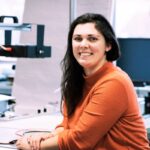 Name and position: Dr. Christina Toigo, Professorship of Hydrogen Technology and Energy Storage, University of Applied Sciences Upper Austria
Name and position: Dr. Christina Toigo, Professorship of Hydrogen Technology and Energy Storage, University of Applied Sciences Upper Austria
Title: Increasing battery sustainability on material side
Research Themes: Hydrogen Technology and Energy Storage with focusses on battery electrodes and lithium-ion batteries.
Abstract:
About the Speaker: Christina Toigo received her Masters degree in polymer chemistry from the Johannes Kepler University Linz, Austria and a PhD in electrochemistry from Alma Mater Studiorum – Universitá di Bologna, Italy. She has been in the field of electrochemistry and battery technology for more than 9 years in both industry and research, working on lithium- and sodium-ion batteries and combined systems for energy storage and hydrogen generation. She currently holds a professorship in “Hydrogen Technology and Energy Storage Systems” at University of Applied Sciences Wels, Austria, where she is focusing on sustainable materials, integration of complex energy systems and innovative approaches within this field. In her lectures, she shares real-world applications and practical insights, making complex concepts easily comprehensible.
WTUN Exchange Programme: Speaker Series – Professor Fiona Macaulay, Professor of Gender, Peace and Development (UOB visits UFRN)
WTUN Exchange Programme: Speaker Series
Watch the Replay:
Date: Tuesday 25 July 2023
Time: 11:00 – 12.00 (BST)
Speaker: Professor Fiona Macaulay, Professor of Gender, Peace and Development Director, Rotary Peace Centre, Department of Peace Studies and International Development, University of Bradford
Exchange: Universidade Federal do Rio Grande do Norte – UFRN.
About Prof Macaulay:
I am Professor of Gender, Peace and Development in the Department of Peace Studies and International Development at the University of Bradford, England, where I am also Director of the Rotary Peace Centre. I research women’s movement, politics, human rights and criminal justice reform in Brazil especially, and Latin America more generally.
I spent two weeks at the Federal University of Rio Grande do Norte, in Brazil, collaborating with colleagues in anthropology, law and gender studies. I gave classes on refugee rights; delivered seminar papers on my recent book on femicide and on my research on the roots of human rights abuses in incarceration practices; ran a theatre workshop at a community-run prison; carried out interviews with police elected to political office in the state; and interviewed/accompanied the special domestic violence patrol units, run by the military police and municipal guard.
My current research concerns policing and prevention of femicide (intimate partner homicide) and the motivations and impacts of police officers running for elected office. I have a long-run research interest in human-rights compliance in the Brazilian prison system.
Join us for a series of webinars focussing on the participants of 2021/22 WTUN Exchange Programme (www.wtu-n.net/exchanges/). In this series, the WTUN has invited colleagues who successfully applied for funding to reflect on their experience of collaboration via the World Technology Universities Network, the impact of this partnership and plans for future research/inter-network collaboration. Speakers will also deliver a short presentation on their current research focus.
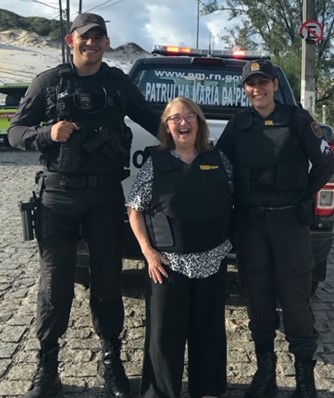
Overall assessment:
From the perspective of my hosts at UFRN, the reframing of their research in social sciences as ‘social technologies’ was very useful. Juliana Melo mentioned it several times in events, as they had never had a WTUN exchange in the area of social sciences. In some ways this reconceptualization of the social impact of their work in anthropology and law (the two departments I interacted with) constituted both a validation and reframing of their research and how it might be perceived within the academic footprint of the UFRN.
For me personally, as you can see from the above account, the visit was tremendously useful in terms of my research agenda, affording me otherwise inaccessible opportunities for participant observation, and for research in an area of Brazil that is understudied not just by international scholars, but by Brazilian scholars and policy-makers alike.
WTUN Exchange Programme: Speaker Series – Featuring Hindustan Institute of Technology and Science, King Mongkut’s University of Technology and Universiti Teknologi Malaysia
Watch the Replay:
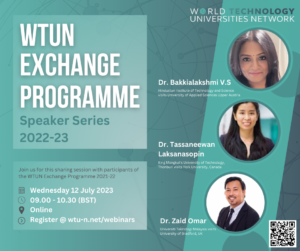
Date: Wednesday 12 July 2023
Time: 09.00-10.30 (BST)
Speakers:
Dr. Bakkialakshmi V.S, Research Scholar, Faculty of Computing Sciences, Hindustan Institute of Technology and Science
Dr. Tassaneewan Laksansopin, Director, Hatch Student Incubator, King Mongkut’s University of Technology
Dr. Zaid Omar, Associate Professor, Faculty of Electrical Engineering, Universiti Teknologi Malaysia
Hindustan Institute of Technology and Science visits University of Applied Sciences, Upper Austria.
‘International Collaboration with HE Institutions – Post Covid’
About the speaker: Dr. Bakkialakshmi. V.S is currently a research fellow and teaching faculty. Her qualification is M.Sc., M. Phil., M.E., (PhD) in computer science engineering. She has 15+ years of experience in Teaching + Research + Administration. Her research interests are carried in the field of Affective Computing on Emotional Psychology. 10+ publications in the same research area with the following achievements.
King Mongkut’s University of Technology visits York University, Canada.
“The purpose of this exchange was to develop new connections between Hatch, a student incubator
at the King Mongkut’s University of Technology Thonburi, and Innovation York at York University to
improve our ability to support innovation and entrepreneurial education, particularly in light of the
current global economic situation and the COVID-19 outbreak…This exchange provided an opportunity to learn about the complexities of developing entrepreneurship and business programs and new educational concepts, both at a university and a community level. The meetings and discussions focus on the lesson learned in entrepreneurial education and support services by the university.”
About the speaker:Dr. Tassaneewan Laksanasopin is currently holding three roles as an Assistant to the President for Innovation and Entrepreneurship, Head of Hatch (KMUTT Student Incubator), and Lecturer in the Biological Engineering Program. With a Ph.D. in Biomedical Engineering from Columbia University, she brings a unique blend of scientific research and entrepreneurial passion. Driven by her commitment to improving outcomes, she has initiated new courses and activities to promote entrepreneurship education and develop entrepreneurial skills in students. With her expertise and dedication, she actively drives innovation, fosters entrepreneurship, inspires the next generation of change-makers, and supports technology commercialization and spin-offs from university technologies.
Universiti Technologi Malaysia visits the University of Bradford, UK.
“The area of focus (for the exchange visit) was computer vision and image processing, which falls under the broader field of Electronic Engineering and Artificial Intelligence. Throughout the visit, I was exposed to the detailed works of Prof Ugail (bradford.ac.uk/staff/hugail/ his team, and his students at the Centre for Visual Computing. My visit also comprised laboratory visits and research discussions. In particular, we focused our discussion on solving the problem of recognising people’s ethnicity and clothing based on video surveillance footage. My initial aim was to facilitate discussion on collaborative efforts on this topic. The theme of the visit was…geared towards discussing a way forward for long-term collaboration between Prof Ugail’s research team and ours, including establishing communication, quick-win strategies, hot topics in research, and possible funding opportunities.
About the speaker: Dr. Zaid Omar is an Associate Professor at the Faculty of Electrical Engineering, Universiti Teknologi Malaysia (UTM). Dr Zaid completed his PhD at Imperial College London in 2012, working on image fusion algorithms. Dr Zaid’s primary research interests are in image processing, medical imaging, and artificial intelligence. He was a Visiting Researcher at the Centre for Visual Computing at the University of Bradford, UK, and is an associate member of UTM-IJN Cardiovascular Engineering Research Centre. Dr Zaid has vast experience managing research and consultancy grants, and has collaborated closely on various projects including with The National Heart Institute (IJN), Pharmaniaga Berhad and The Malaysian Palm Oil Board (MPOB). He has published over 40 works in the field and has successfully supervised a number of postgraduate students.
The WTUN presents International Women in Engineering 2023: ‘Make Safety Seen’
The WTUN presents International Women in Engineering 2023 ‘Make Safety Seen’
Watch the replay:
Event: In celebration and recognition of InWED (www.inwed.org.uk/) This webinar featured prominent speakers from Science and Engineering from WTUN member universities, hosted by colleagues from the University of Bradford. In addition, the WTUN is pleased to confirm it is collaborating with ATU-Net for this event and so will be welcoming colleagues from ATU-Net member universities.
Speakers: We heard from seven speakers across the two-hour session. The programme featured speakers specialising in Architectural, Environmental, Biological, Chemical and Mechanical Engineering from Bahrain, Indonesia, Malaysia, Thailand & the UK.
Date: Friday 23 June 2023
Time: 11.30-13.30 (BST/GMT+1)
Registration Form: click HERE

Hosted/Chaired by (University of Bradford):
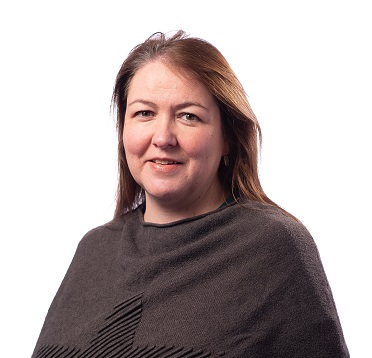 Name and Position: Dr Elaine Brown, Reader / Associate Dean (EDI) https://www.bradford.ac.uk/staff/ebrown/
Name and Position: Dr Elaine Brown, Reader / Associate Dean (EDI) https://www.bradford.ac.uk/staff/ebrown/
Name and Position: Dr Cristina Tuinea-Bobe, RKT Business Development Manager https://www.bradford.ac.uk/staff/ctuineabobe/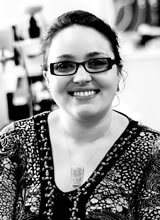
Cristina has two multi-disciplinary PhDs: one in biomedical engineering and one in semiconductors’ electronics. She is now based at the University of Bradford in the Faculty of Engineering and Informatics working as Research & Knowledge Transfer Business Development Manager. Her role is to facilitate academics interaction with government and industrial funding bodies, resulting in high quality proposals and projects. Cristina is promoting our mission to provide superior quality education with a high impact on industry, and on the country’s economy, through our ‘make a difference’ alumni cohort.
Speakers:

Name and position: Dr. May Alsaffar, Assistant Professor/Chairperson of the Department of Interior Design, Ahlia University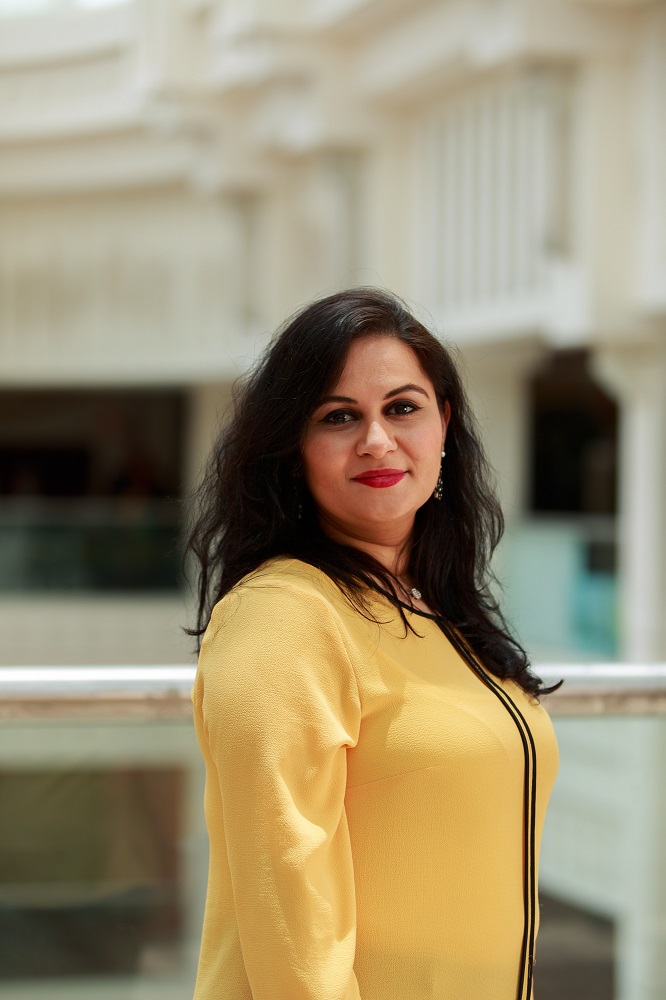
Title: ‘Towards Safe and Comfortable Built Environments: Human Factors and thoughtful Architecture’
Abstract: Human factors and architecture are both important considerations for ensuring safety in built environments. Human factors refer to the physical, cognitive, and social characteristics of people that influence their behaviour and performance. Architecture, on the other hand, refers to the design of buildings and other physical structures.
When designing buildings or other structures, it is important to consider human factors to ensure that the environment is safe and comfortable for the people who will use it. Architects and designers need to consider factors such as lighting, acoustics, temperature, and ventilation to create an environment that is conducive to productivity and wellbeing. They also need to consider the needs of people with disabilities, such as wheelchair users, and ensure that the building is accessible to them. factors also play a role in the design of safety features in buildings. For example, emergency exits and fire alarms need to be placed in locations that are easily visible and accessible to people in the event of an emergency. Signs and other visual cues need to be designed to be easily understood by people of different ages, cultures, and languages.
In addition to designing buildings with human factors in mind, it is also important to educate people on how to use the built environment safely. This includes providing training on how to use safety features such as fire extinguishers and emergency exits, as well as educating people on how to navigate the building in a safe and efficient manner. Overall, a combination of careful consideration of human factors and thoughtful architectural design can contribute to creating safe and comfortable built environments.
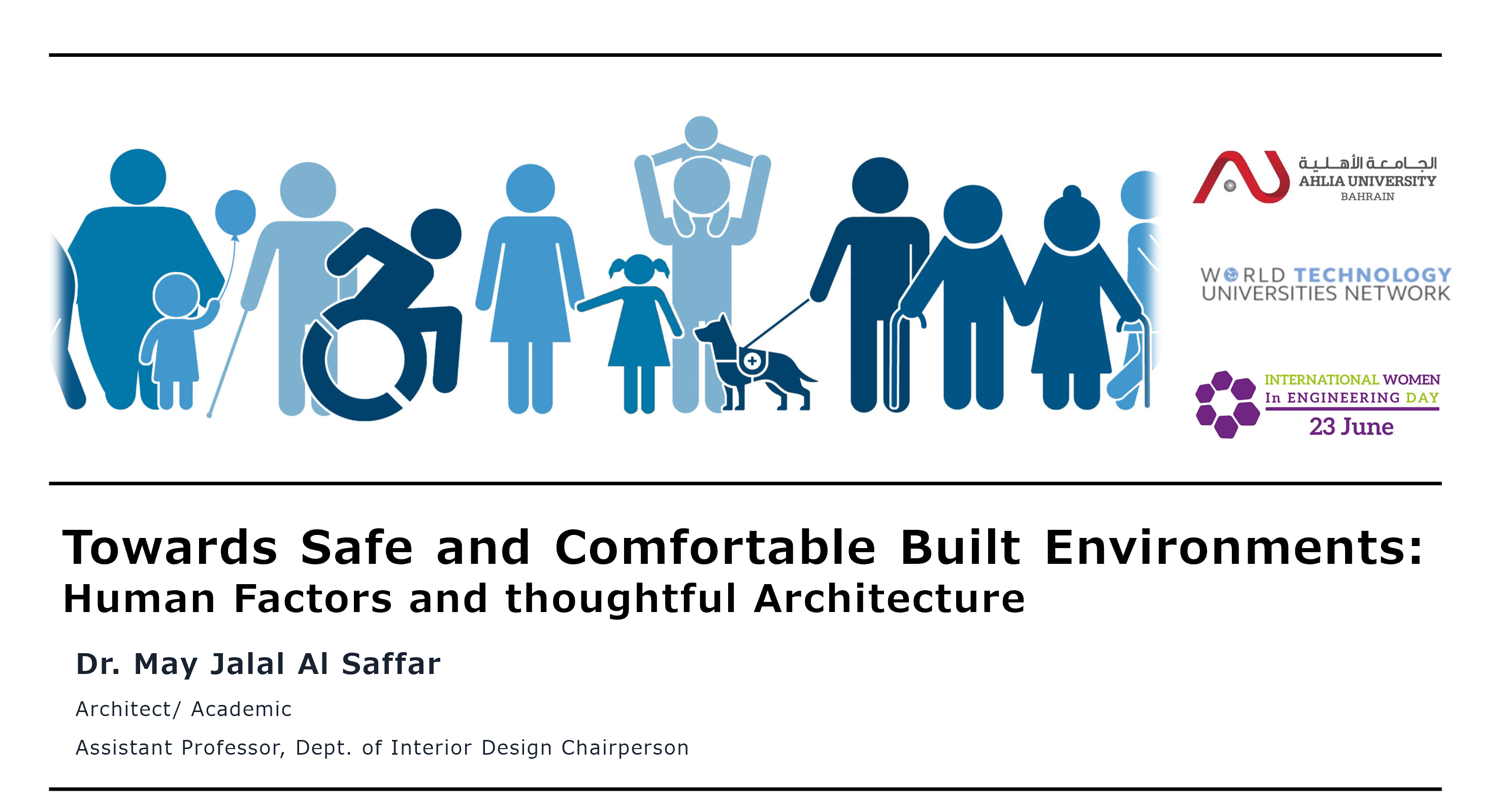
About the Speaker:
Motivated Assistant Professor with 10+ years of experience specializing in Architecture and Interior Design. Strong background in creating insightful course contents and research papers which increased University exposure and helped students’ learning development. Swiftly establishing strong relationships with pupils, increasing class engagement and enjoyment.
Prior to joining Ahlia University, May served as an Architect, interior designer, and urban designer in well-known design firms in Bahrain such as Ahmed Janahi Architects, Jalal Engineering, Apex Green, and AAA homes.
May also has served as a visiting faculty, Kingdom University (BAH), as a researcher at the Bauhaus Dessau Foundation, Germany, and as a Teaching and Research Assistant at the United Arab University during her Ph.D. studies (UAE). She also participated as an external juror for graduation projects and design studios at the University of Bahrain and abroad.
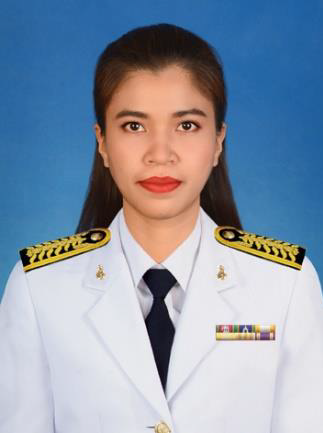 Name and position:Dr. Naruemon Intarat , Lecturer of Mechanical Engineering, Thaksin University
Name and position:Dr. Naruemon Intarat , Lecturer of Mechanical Engineering, Thaksin University
Title: Human Factors Influencing Women in Engineering
Abstract: “Most females considered engineering to be a male field, hence the low number of female engineering students. Females are underrepresented in engineering cohorts. However, engineering pathways for women are possible. Common influencing factors for female participation in the selection of engineering pathways included parental and teacher influences, self-efficacy, perception and attitude, gender stereotypes, and peer and media influences.
Self-Efficacy, perception, and attitude are important for all humans, everyone is equal “Do whatever you want to do”.”
About the Speaker: B.Eng. (Mechanical Engineering), M.Eng. (Mechanical Engineering), Doc.Eng. (Power Engineering and Engineering Thermophysics)
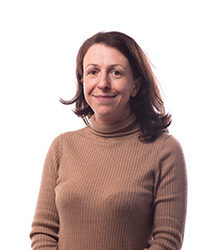
Name and position: Dr Maria Katsikogianni, Assistant Professor in Biomaterials Chemistry, University of Bradford
Title: ‘Harnessing nano-patterning and incorporation of antimicrobials to manufacture orthopaedic trauma implants that resist microbial colonisation ‘
Abstract: “More than 2 million people/year in the UK suffer a bone fracture that is addressed primarily using metal implants. Such implants facilitate microbial colonisation which can lead to medical device associated infections. Antimicrobial strategies can involve modification of the medical device biomaterial surface rendering it less amenable to colonisation. In this respect, the aim of this study was to evaluate the engineering of biomaterial surfaces at the nanoscale, with or without the addition of antimicrobials, for the preparation of orthopaedic trauma implants that prevent microbial colonisation.
Materials and Methods: VICTREX® PEEK with or without glass fibre reinforcement were micro-injection moulded using a Wittman Battenfeld Micropower moulding system and flat or nano-patterned mould inserts. Polydimethysiloxane (PDMS) and 1% or 10% (w/w) triclosan impregnated PDMS were compression moulded on a flat or nano-patterned mould. The moulded components were physicochemically and mechanically characterised. Their non-fouling and antimicrobial performance was assessed against bacterial adhesion and subsequent biofilm formation of Gram-positive and Gram-negative bacteria.
Results and Discussion: Geometric characterisation of the moulded surfaces showed excellent replication of the mould inserts at the nanoscale, with the exception of the 10% triclosan impregnated PDMS. Of note was that 1% triclosan killed all tested bacteria on both flat and patterned surfaces within 1 h. In the case of PDMS without triclosan and PEEK, patterned surfaces reduced bacterial adhesion and biofilm formation. Reproducible pattern replication was important for ensuring enhancement of the antimicrobial/non-fouling activity. This combined physical and chemical strategy provides a novel approach to generating non-fouling properties to medical device biomaterials.
Acknowledgments: Professor Ben Whiteside is acknowledged for his collaboration in the area of injection moulding. This work was funded by MeDe Innovation, the EPSRC Centre for Innovative Manufacturing in Medical Devices, under a “Fresh Ideas” Feasibility Study Funding Award.”
About the Speaker: I am an Assistant Professor in Biomaterials Chemistry, at the University of Bradford and I contribute to research and teaching in the areas of materials, materials characterisation, materials interactions with biological environments and microscopy. My research aims at understanding how material properties affect bacterial/cell adhesion, so that we get to prepare materials for a range of applications; medical devices, clinical settings, food packaging, amongst others.
With a BSc in Chemistry and a PhD in Biomedical Engineering, I am the first female in my family to study Science and to do a PhD and I am proud of the young generation and the opportunities provided to them.
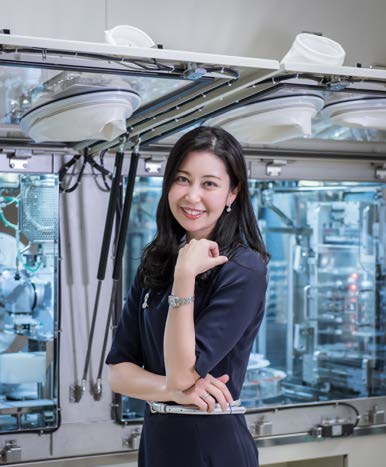 Name and position: Assoc. Prof. Dr. Kwanchanok Viravaidya-Pasuwat, Associate Professor, Department of Chemical and Biological Engineering, King Mongkut’s University of Technology Thonburi
Name and position: Assoc. Prof. Dr. Kwanchanok Viravaidya-Pasuwat, Associate Professor, Department of Chemical and Biological Engineering, King Mongkut’s University of Technology Thonburi
Title: ‘Transforming Cell-Based Therapy: Utilizing Automated Cell Processing Systems for Enhanced Safety and Efficiency’
Abstract: “Regenerative medicine has emerged as a promising field revolutionizing medical treatments and poised to become a significant contributor to the global economy. The goal of regenerative medicine is to stimulate the body’s repair mechanisms using healthy cells or tissues. Autologous transplantation of stem cells or primary cells represents a widely practiced regenerative medicine therapy. However, manual isolation and culturing of these cells present challenges, including labor-intensive and time-consuming processes, susceptibility to bacterial contamination, limited production capacity and reliance on highly skilled technicians. To address these concerns, automated cell processing systems have been introduced to streamline and standardize cell cultivation. These systems typically employ robot arms within closed, sterile cabinets to handle various cell processing functions.
In light of therapeutic potential, we propose the establishment of a cell manufacturing facility utilizing an automated cell processing system. Our initial focus is on producing autologous chondrocytes and autologous bone marrow-derived stem cells for clinical studies. These studies are essential to evaluate the quality of cells generated using the automated system and assess the efficacy of the cell-based therapies.”
About the Speaker: Dr. Kwanchanok Viravaidya-Pasuwat graduated with honors, earning a Bachelor of Science degree in Chemical Engineering from California Institute of Technology in 1998. She subsequently pursued her M.S./Ph.D. in Chemical Engineering at Cornell University, where she received a full fellowship and completed her studies in 2004.
Dr. Viravaidya-Pasuwat joined King Mongkut’s University of Technology Thonburi (KMUTT) in 2004 as a lecturer in the Department of Chemical Engineering, Faculty of Engineering. She was promoted to the roles of Assistant Professor in 2008 and Associate Professor in 2013. As one of the pioneering faculty members, she played a vital role in establishing research activities and the curriculum for KMUTT’s Biological Engineering program. From 2013 to 2017, she served as the Director of the Biological Engineering program. Dr. Viravaidya-Pasuwat’s research endeavors revolve around the development of safer, more cost-effective, and easily accessible cell-based therapies, with a particular emphasis on scaffold-free tissue engineering approaches. Her notable contributions include the successful construction of tissueengineered constructs for the treatment of cartilage defects and severe burn injuries. Furthermore, she and her group are actively engaged in leveraging automated cell processing systems for applications in regenerative medicine.
In recognition of her outstanding research work, she was honored with the prestigious L’Oreal-UNESCO “For Women in Science 2014” Fellowship. Through her dedication and innovative research, Dr. Viravaidya-Pasuwat continues to advance the frontiers of regenerative medicine, striving to make significant contributions to the field and enhance the prospects of safer and more accessible cell-based therapies.
Name and position: Assoc. Prof. Dr. Netnapit Tantemsapya, Associate Professor, School of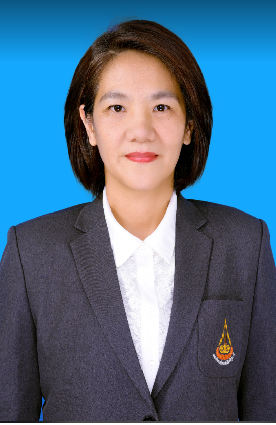 Environmental Engineering, Suranaree University of Technology
Environmental Engineering, Suranaree University of Technology
Title: Laboratory Safety in Academic & Schools in Thailand; Current status, challenges, and future directions
Abstract: There is a growing awareness on Laboratory Safety in Academic & Schools in Thailand in the past two decades. This talk is about the initiative on establishing Thailand’s university and school laboratory safety system. In addition, the current status, challenges and present future directions to reduce accidents using engineering and administrative controls will be presented.
About the Speaker: Dr. Tantemsapya is an Associate Professor at Suranaree University of Technology. She graduated in 1993 with a bachelor’s degree in environmental engineering. She then furthered her study at the New Jersey Institute of Technology, where she received her master’s degree and Ph.D. also in Environmental Engineering and returning to Thailand in 2003 as a Lecturer in the Department of Environmental Engineering at Khon Kaen University and moved to Suranaree University of Technology in 2017.
Her work focuses on pollution prevention, wastewater natural treatment, and Hazardous waste management. Major projects include the fate transport of heavy metals in the environment, water quality modeling, pollution prevention of industries, and designing natural treatment systems. These projects involved collaboration with local/international research institutes and the industrial and governmental sectors.
For ATU-Net:
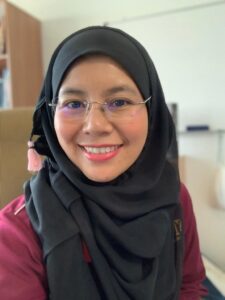 Name and position: Assoc. Prof. Dr. Norhayati Abdullah, Associate Director, UTM International Kuala Lumpur & Associate Professor of Environmental Engineering, Universiti Teknologi Malaysia, Malaysia
Name and position: Assoc. Prof. Dr. Norhayati Abdullah, Associate Director, UTM International Kuala Lumpur & Associate Professor of Environmental Engineering, Universiti Teknologi Malaysia, Malaysia
Title:‘Pivoting Innovative Solutions – Role of Women Wastewater Engineers’
Abstract: Resilience of sewerage systems is of paramount importance considering the impact of untreated wastewater may have on the general health and well-being of human, animals as well as living things. Wastewater treatment and engineering is a field seldom treaded by women however the contributions of women wastewater engineers and academics are undeniably significant in transforming the water and wastewater sectors globally. Let’s have a look on the roles of women wastewater engineers on pivoting innovative solutions in #makesafety seen in wastewater engineering.
About the Speaker: Norhayati Abdullah is currently the Associate Director of UTM International Kuala Lumpur and Associate Professor in Environmental Engineering at Universiti Teknologi Malaysia (UTM). She completed her tenure as a Guest Scholar at the Graduate School of Advanced Integrated Studies in Human Survivability (Shishu-kan), Kyoto University, Japan. Norhayati is recipient of the 2019/2020 ASEAN Science and Technology Fellowship focusing on the strategic recommendations for water sector transformation under the auspices of the Academy of Sciences Malaysia. Norhayati represented UTM and Malaysia at the University of Michigan Ann Arbor for the Fulbright US-ASEAN Visiting Scholar Initiatives in 2016-2017.
In 2018, she received the L’Oréal-UNESCO for Women in Science Fellowship. She was Board of Director of the International Water Association (IWA) from 2014-2018, an IWA Fellow and Council Member of the Malaysian Water Association (MWA). At global level, Norhayati has been actively involved with the IWA program and activities since 2000. She received the IWA Young Water Professional (IWAYWP) Award in 2012 in recognition of her outstanding achievements in wastewater research and active involvement in various Professional development programs.
Norhayati is a certified openwater diver, loves reading and indulge herself in outdoor activities.
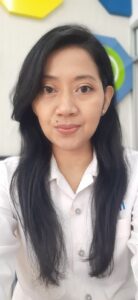 Name and position: Professor Mahendrawathi , Professor and Head of Enterprise Systems Laboratory, Institut Teknologi Sepuluh Nopember, Indonesia
Name and position: Professor Mahendrawathi , Professor and Head of Enterprise Systems Laboratory, Institut Teknologi Sepuluh Nopember, Indonesia
Title: ‘The Key Role of People and Process in Ensuring Workplace Safety and Security.’
Abstract: “Workplace safety and security are two important aspects that need to be attended to. Particularly, in today’s world where technology is pervasive in every aspect of human life. In one way, technology such as robotics, information and communication technology, and artificial intelligence, offers ample opportunity to help humans in conducting their day-to-day activities. On the other hand, it also creates a lot of challenges. While such technology has improved in unprecedented ways, the role of people and processes remains key.
In this talk, I will focus on the use of Information and Communication Technology in particular social media as it plays a big role in my country. Social media in various forms such as Social Networking Sites, Image-based sites, Video sharing/streaming platforms, Discussion forums, and Blogs and community platforms has grown tremendously. Such social media not only helps people to get connected but also helps them to do their tasks on an individual level and to perform their roles at the workplace. WhatsApp for example, has been used by many employers to discuss work-related issues. However, many individuals are unaware of the safety and security measures that they must follow. This includes personal and privacy protection. For example, what is safe to share over social media? How to ensure that your data is protected? These measures must be embedded in the people. The employer also needs to ensure that the process that the employee must perform meet the safety and security standards. “
About the Speaker:
Mahendrawathi ER is a Professor in Business Process Management and the Head of the Enterprise Systems Laboratory in the Information Systems Department, Institut Teknologi Sepuluh Nopember, Surabaya, Indonesia. She received her Ph.D. from Nottingham University, United Kingdom, in 2004. Her teaching and research interests are in Business Process Management, Enterprise Resource Planning, and Supply Chain Management. She has written books in all three areas. Her research has been published in various academic journals. She is passionate to apply her process-oriented skills to help individuals, organizations, and society achieve their goals.
‘Construction of 3D biological morphologies: Application in the Life Sciences’ -Wednesday 24 May
‘Construction of 3D biological morphologies: Application in the Life Sciences’
Date: Wednesday 24 May 2023
Time: 11.00-12.00 (BST)/12.00-13.00 (CEST)
Speaker: Professor Dr. Andreas Schober, TU Ilmenau
Registration Link: Closed
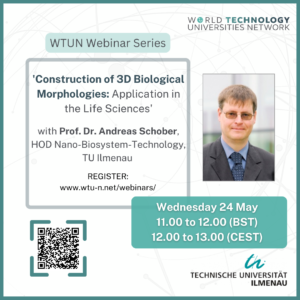
Overview:
The fusion of classical engineering methods like micro system technology with life sciences like tissue engineering, advanced cell culturing and molecular biology promises the development of a “toolbox” (which one might call “biolithomorphie”) for modelling real biological systems. Such an approach of nanobiosystem research is dedicated to the examination and reproduction of biological systems under the aspect of “biotechnical multiscale engineering”. By this we mean a systems biology view that considers that, for example, macroscopic biological systems also represent a synthesis of functional nano- and microelements. For the systems approach and the associated post-modelling, it must therefore be taken into account that both the smallest functional elements and the next higher units are necessary for the function of biological systems. Both the geometric dimensions and the hierarchical, respectively compartmentalized links and organisational principles play a role here.
The kernel of such a research program is the designing of 3D structure for artificial cellular substrate and systems. First, micro fluidic devices for advanced cell cultivation and their capability to provide original three-dimensional biological microfluidic environments have to be designed. Second, is the construction of 3D scaffolds using advance polymeric materials by different means of fabrication techniques. Among them are the methods for micro machining of polymeric cell supports, organ printing methods, chemical pattern guided cell cultivation and the design of 3D structures by irradiation induced polymerization of artificial polymers. Research of such methods aims for the construction of technical systems which are closely mimicking the real biological environment. In this talk we review the representative developments in this research field and the fusion of the different disciplines with potential for new applications in the life sciences e.g. stem cell research.
#Nanosystemintegration #3DCellCultivation #OligocellularCellSystems #StructuringOfPolymers #Microfluidics #Bioreactors #Biolithomorphy.
About the speaker:
Professor and Head of Department Nano-Biosytems-Technology of TU Imenau, Professor Andreas Schober research interest is focused in the last years on biological systems and their emulation within the frameworks of Biotechnical Multi-scale Engineering (BME). The term BME stands for the extraction of all these basic physical scales and functional principles in a biological system, ranging from the sub-nanometer distances between lipids in a bilayer and the micron diameters of capillaries to the macroscopic dimensions and functionality of whole organs. Together these components form the 3D environment which is to be artificially created. Applications of BME range from the Life Sciences to Medical and Biotechnology.
Selected publications:
1. Mai, P, Schober, A., et al. , MatriGrid Technology Bioengineering 2022, 9(5), 220
2. Marx-Blümel, L., Marx, C., Sonnemann, J., Schober et al. Sci Rep 11, 21163 (2021). https://doi.org/10.1038/s41598-021-00619-6
3. Marx-Blümel, Schober, et al. Biomimetic reconstruction of the hematopoietic stem cell niche cells. – In: PLOS ONE. – : PLOS, ISSN 1932-6203, 15 (2020), 6, e0234638, Seite 1-17 ttps://doi.org/10.1371/journal.pone.0234638
4. Borowiec, J; Schober, A et al. 3D Microcontact Printing for Combined Chemical and Topographical Patterning on Porous Cell Culture Membrane June 2018ACS Applied Materials & Interfaces 10(26) DOI: 10.1021/acsami.8b06585
5. Bingel, C; Schober, A.; Witt, O.; Oehme, I. Three-dimensional tumor cell growth – In: Cell death & disease, ISSN 2041-4889, Bd. 8 (2017), (24. Aug.), e3013, insges. 16 S. https://doi.org/10.1038/cddis.2017.398
6. Baca, M.; Schober, A. et al. Microbial electrochemical systems – In: Advanced energy materials, ISSN 1614-6840, Bd. 6 (2016), 23, 1600690, insges. 10 S. http://dx.doi.org/10.1002/aenm.201600690
7. M. Gebinoga, Th. Klar, A. Schober, et al., Eng. Life Sci. 2013, 368-375
8. Fernekorn U., , A. Schober, et al., RSC Advances, 2013, 16558 – 16568, DOI:10.1039/C3RA42358A.
9. Williamson, S. Singh, U. Fernekorn, and A. Schober, Lab on a Chip, vol. 13, pp. 3471-3480, April 2013.
10. F. Weise, U. Fernekorn, J. Hampl, M. Klett, A.Schober, Biotechnology & Bioengineering 2012, 2504-2512, DOI 10.1002/bit.24912
11. Singh,S; Hampl, Tobola, J; Fernekorn, U; A. Schober, BioNanoMaterials, 2013, 14(1), P123, Page 196
12. U. Fernekorn, A. Schober, et al. Eng. Life Sci. 2011, 11, No. 2, 133-139
13. A. Groß, A. Schober, et al., Angew. Chem. Int. Ed. 2006, 45, 3102 –3106.
14. J. Burgold, A. Schober, et al., Macromol. Rapid Commun. 2005, 26, 265–280
15. A. Schober, et al., Microsystem Technologies (2004), Band 10 Vol. 4.
16. Schober A. et al. Accurate high-speed liquid handling of very small biological samples. Published 1 August 1993 BioTechniques
Prescriptive Analytics and Industrial AI: Only those who know the past and understand the present can shape the future – Thursday 16 March
Watch the replay: https://youtu.be/clHxDQPHIeE?si=U4_rTY_g_aoD9G9H
Overview:
Artificial intelligence has been used for decades – sometimes more, sometimes less prominently – as an umbrella term for a variety of underlying methods and approaches. Especially in recent years, we observe an increasing importance and impact of AI technologies in many areas of life due to the amount of available data in terms of quantity and quality in combination with the increasing performance of parallel computer systems has led to a stronger focus on these technologies – especially in the area of machine learning. A discipline that builds on this and is particularly relevant for industrialized regions is prescriptive analytics.
Prescriptive analytics is a cross-sectional topic in a cross-sectional discipline or, in other words, a synergetic hybridization of various methods and algorithms from statistics, computer science, artificial intelligence, mathematics and operations research. Its aim is to provide optimized recommendations for action in various application areas. In this way, knowledge gained in the digital world is brought back to the real world, providing better and more efficient procedures, designs and processes.
About the speaker:
Michael Affenzeller is professor for heuristic optimization and machine learning at the University of Applied Sciences Upper Austria. He graduated in mathematical computer science and did his doctorate and habilitation in computer science with a special focus on applied systems science.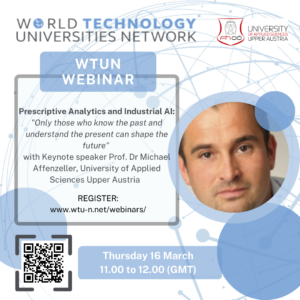
Concerning University administration Michael Affenzeller served as vice-dean for R&D at Hagenberg campus and as the scientific head of the Softwarepark Hagenberg between 2014 and 2022. Since July 2022 he serves as provost of the University of Applied Sciences Upper Austria. He has published over 300 peer-reviewed papers in journals and collective volumes.
Bringing together machine learning, simulation-based optimization and meta-heuristics with a special focus on adaptive search in dynamic environments in the context of prescriptive analytics is Michael Affenzellers research focus for the next years.
Introduction:
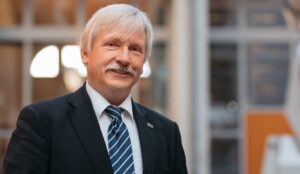 Professor Peter Scharff, Chair of the World Technology Universities Network, Professor and former Rector of TU Ilmenau will introduce this lecture.
Professor Peter Scharff, Chair of the World Technology Universities Network, Professor and former Rector of TU Ilmenau will introduce this lecture.
![]()
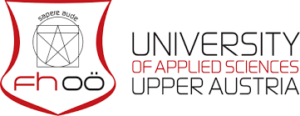
The World Technology Universities Network in collaboration with Asia Technological University Network (ATU-Net) for ATU-Net World Engineering Day 2023
Held live – Monday 6 March 2023 08:00 – 09:30 (UTC)/16:00 – 17:30 (UTC+8)
Hosted by Universiti Teknologi Malaysia (UTM), ATU-Net WED 2023 highlights the theme “Celebrating Engineers: Towards Sustainable Innovation in Engineering”, which will feature a sharing session by prominent speakers of member universities from both Networks.
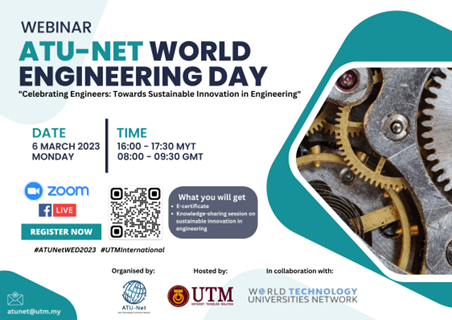
Details of the programme are as follows:
Date: 6 March 2023 (Monday)
Time: 16:00 – 17:30 (UTC+8) / 08:00 – 09:30 (UTC+0)
Mode: Virtual on Zoom and Facebook Live (ATU-Net)
Fee: Free of Charge
Registration Link: https://forms.gle/T43XYNwxjCDPE5PR9
Registration Deadline: 3rd March 2023 (Friday)
Website: https://atunet.org/atunetwed2023/
ATU-Net WED 2023 is designed in conjunction with the World Engineering Day for Sustainable Development which is celebrated every 4th March beginning in 2020, proclaimed by UNESCO at its 40th General Conference in 2019. As an international alliance which focuses on Engineering and Technology, ATU-Net takes pride in recognising and honouring the valuable contribution of all excellent engineers of ATU-Net member institutions and beyond in advocating sustainable innovation in engineering for our next generation.
Participants of this event will be provided with an e-certificate at the end of the programme.
To view the details of previous WTUN led webinars, visit here.


